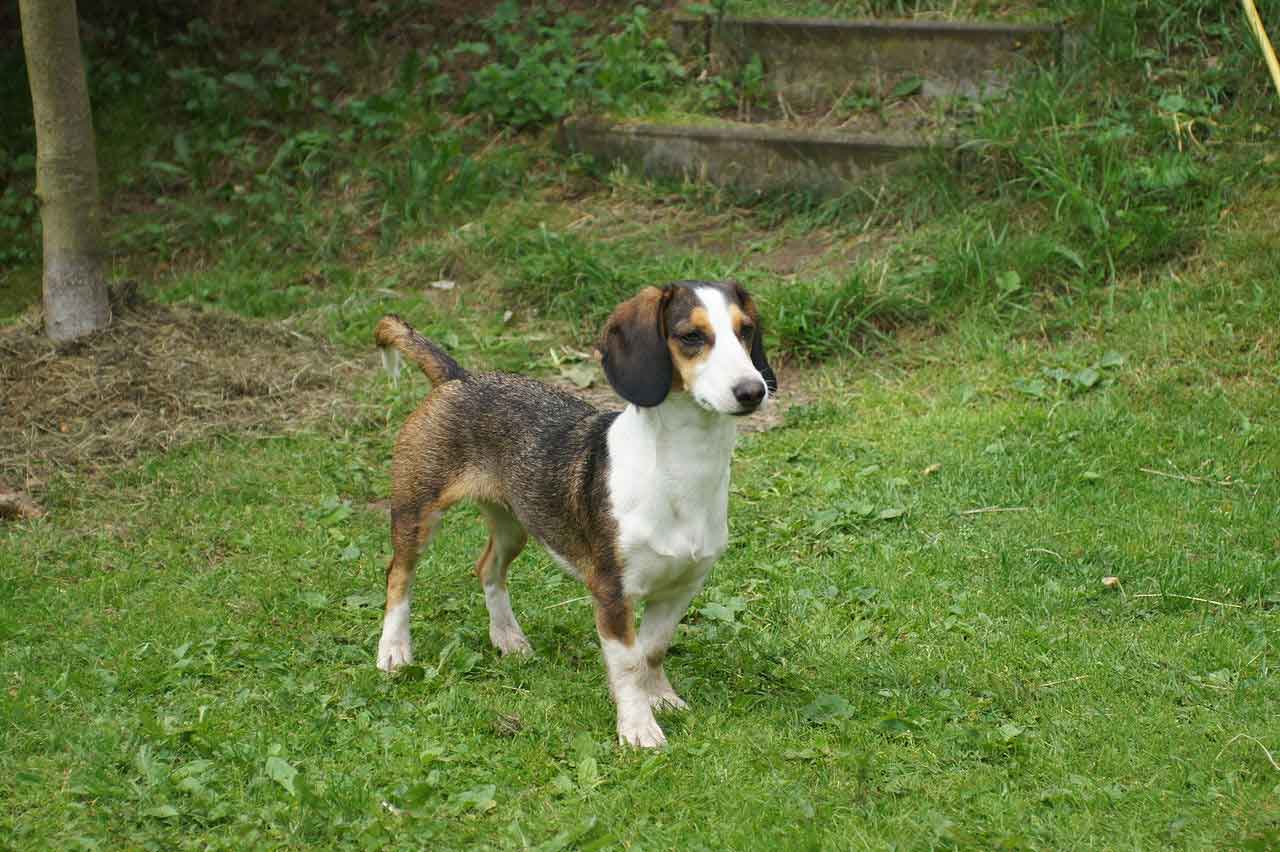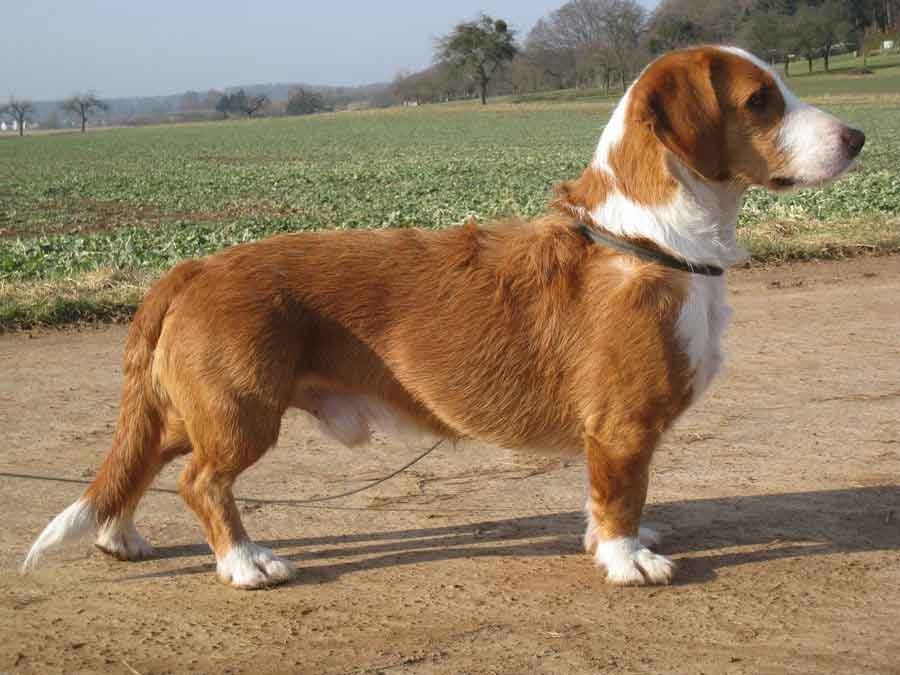Content |
|---|
History
The Westphalian Badger Dog was developed in the 17th century in Germany, in the region between the Rhine and the Weser. The result of the cross between the German Hound and various types of Dachsbrack, was created to satisfy the need for a fast dog, small and short, able to cut through bushes and chase prey into burrows. They were the favorite companions of the Germanic nobles, who were so appreciated for their ability to hunt hares, rabbits and foxes as per their friendly disposition.
It is mentioned in the official description of the German Hound in the decade of 1880, and a first standard was established in 1910. But, the breed was not recognized by the German Kennel Club until 1935, and then by the FCI in 1954.
The Westphalian Dachsbracke It, However, rare outside Germany. It also, among the main canine organizations in the Anglo-Saxon world, only the UKC recognizes this breed, and only from 2006.
Photo: Westphalian Dachsbracke by Volbu1, CC BY-SA 3.0, via Wikimedia Commons
Physical characteristics
The Westphalian Dachsbracke It is a small hound that measures between 30 and 38 cm at the withers and weighing about 15 kg. It seems to the German Hound, which is even considered a miniature version.
His coat is tricolor, combining black, red and white. White markings are found on the neck, the chest, the snout, paws and tail tip. Bi-color is not accepted. The coat is rough and very tight, medium length in the back, neck and back of the tail, but short in the rest of the body.
With a slightly elongated skull and a slightly accentuated stop, his head clearly evokes his kinship with the other double basses. His eyes are dark, while his ears, big and long, are flat against the head.
The tail, strong and tall at the base, is in perfect extension of the line of the back. It is carried out with a saber blade or hanging.
Character and skills
The Westphalian Dachsbracke he's a smart working dog, stubborn and tenacious who can follow the trail of prey over great distances without hesitation.
They are primarily hunting dogs that maintain an active temperament and a great need for exercise. This need must be met each day to prevent the dog's destructive behavior.. Live in an apartment, although it is not recommended, it is possible as long as the dog can take long walks at least twice a day. During these walks, it is strongly recommended to keep it on a leash, in case you smell prey that takes you off the beaten track. But, ideally it would have access to a garden.
In the home, although he is not the most docile of dogs, the Westphalian Dachsbracke shows a lot of attachment and affection for his master, family loyalty, and gets along very well with children. All these are qualities that make it a very pleasant companion dog.. But, requires a lot of interaction and availability, as he needs constant company and cannot be left alone for a whole day. Playtime and obedience or agility training can keep you busy, but nothing will make you happier than a hunting trip.
Finally, the Westphalian Dachsbracke tolerate other pets as long as they are exposed to your presence from a young age. Otherwise, his hunting instincts take over, and is capable of chasing and hurting them.
Education
Due to its firm character, the Westphalian Dachsbracke can be tough and stubborn in his upbringing. Some commands will take longer to assimilate than with other dog breeds. So, the master must act as the leader of the pack to be heard and obeyed, and under no circumstances allow him to take over the family hierarchy. So, it is clearly important not to be fooled by the small size of this dog and to turn it into a “Princess”, at the risk of experiencing real cohabitation problems in the near future.
At the end, the Westphalian Dachsbracke must be trained early and firmly, while promoting the principles of positive dog training.
Health
The Westphalian Dachsbracke he is a robust dog, healthy and with a good life expectancy. But, their kinship to the Basset family explains why they are prone to back problems, ranging from muscle tension to degenerative disc disease.
It also, you have to be careful with his long and floppy ears, as they are sensitive to ear infections. In case of infection, the dog tends to shake its head and scratch its ear. Other signs are a bad smell and the development of redness around the ear canal.. An ear infection requires a visit to the vet and is treated with prescription medications..
Last, like any working dog, a Westphalian Dachsbracke that participates in hunting is more likely to be injured than a companion dog that is kept at home. But, in the heat of the moment, the dog tends to ignore pain, so it is often only after the owner notices lacerations or bites, for example.
Grooming
One to two weekly brushings are recommended to maintain the very tight and rough-textured coat of the Westphalian Dachsbracke. These dogs should rarely be bathed, since they deprive the coat of its natural oils.
The ears should also be visually inspected at least once a week and they should be dried after soaking in water to limit the risk of infection..
Last, the dog's teeth should be brushed regularly to reduce the risk of periodontal diseases and infections, that one day may require dental extractions.
Characteristics "Westphalian Dachsbracke"
Coexistence is important that you have with your new friend. Before considering the acquisition of a dog of the breed "Westphalian Dachsbracke" you know certain factors. Not all breeds of dogs are apt to live in an apartment, you must take into account his character, their need for exercise, their interaction with other pets, their care and if you have small children, their level of tolerance towards them.
Adaptation ⓘ2.0 out of 5 stars (based on 1 review)
|
friendly dog ⓘ3.0 out of 5 stars (based on 1 review)
|
hair loss ⓘ3.0 out of 5 stars (based on 1 review)
|
|---|---|---|
Affection level ⓘ3.0 out of 5 stars (based on 1 review)
|
Need for exercise ⓘ3.0 out of 5 stars (based on 1 review)
|
Social need ⓘ3.0 out of 5 stars (based on 1 review)
|
Home ⓘ3.0 out of 5 stars (based on 1 review)
|
Toilet ⓘ2.0 out of 5 stars (based on 1 review)
|
Friendly with strangers ⓘ3.0 out of 5 stars (based on 1 review)
|
barking ⓘ3.0 out of 5 stars (based on 1 review)
|
Health ⓘ3.0 out of 5 stars (based on 1 review)
|
Territorial ⓘ2.0 out of 5 stars (based on 1 review)
|
Cat friendly ⓘ2.0 out of 5 stars (based on 1 review)
|
Intelligence ⓘ4.0 out of 5 stars (based on 1 review)
|
Versatility ⓘ4.0 out of 5 stars (based on 1 review)
|
Child friendly ⓘ3.0 out of 5 stars (based on 1 review)
|
Surveillance ⓘ2.0 out of 5 stars (based on 1 review)
|
joy ⓘ4.0 out of 5 stars (based on 1 review)
|
Images "Westphalian Dachsbracke"


Videos "Westphalian Dachsbracke"
|
Westfälische Dachsbracke – Jagd: Weidmannsheil!
|
Jersey (Rhodesian Ridgeback) & Lea (Westfälische Dachsbracke) Sparring Nr. 2
|
|---|
Type and recognitions:
- FCI CLASSIFICATION: 100
- Group 6: Scent hounds, and related breeds.
- Section 1.3: Small-sized hound-type dogs.. With proof of work..
Federations:
- – FCI – Group 6: Scent hounds, and related breeds. – Section 1.3: Small-sized Hounds. ⓘ
- – UKC – Scenthounds ⓘ
FCI breed standard "Westphalian Dachsbracke"
Alternative names:
1. Westphalian Hound (English).
2. (Westfälische Dachbracke en allemand) (French).
3. Westfälische Dachsbracke (German).
4. (em alemão: Westfälische dachsbracke) (Portuguese).
5. Cazador de Westfalia (español).
